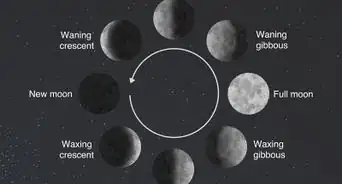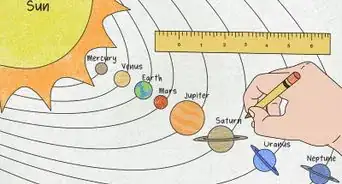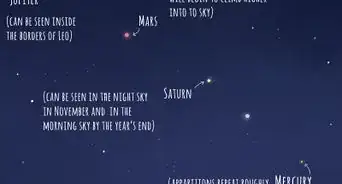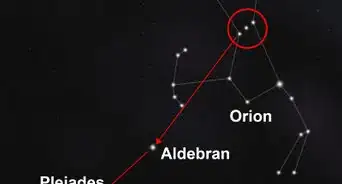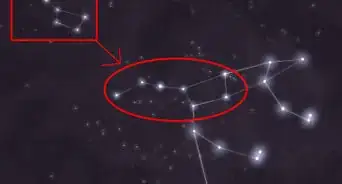This article was co-authored by wikiHow Staff. Our trained team of editors and researchers validate articles for accuracy and comprehensiveness. wikiHow's Content Management Team carefully monitors the work from our editorial staff to ensure that each article is backed by trusted research and meets our high quality standards.
There are 7 references cited in this article, which can be found at the bottom of the page.
This article has been viewed 56,962 times.
Learn more...
If you were interested in naming a star after yourself or someone you know, several companies offer services to name your own star. Note that the star won't be the official name of the star and it's likely that the star has already been named something else in another registry. While the name won't be official, you'll receive a certificate and other astronomical gifts that will make you or someone you know feel special.[1] Officially, most stars have already been cataloged with a series of letters and numbers. However, larger, more significant stars usually have a unique name given to them by different cultures or astronomers.
Steps
Naming a Star Online
-
1Search online for star-naming registries. Several non-official, for-profit online registries offer star naming services. These registries give you a certificate for your star and other items like photographs of constellations, a star map, fact sheets, and space-themed accessories. Most packages will also include instructions on how to find your star in the sky. Look online at different companies and compare what they offer to help narrow down your decision.[2]
- The only official registry is the International Astronomical Union (IAU). They define how stars and other celestial bodies are officially named for astronomical and scientific purposes.
-
2Compare gift packages and choose the one you like the best. Most online star-naming registries will have different packages that you can buy. If you want to get more merchandise, you’ll have to purchase a more expensive package. Look at the different packages and choose one based on your budget and what they have to offer.[3]
- Star naming packages typically cost anywhere from $30 to $100.
Advertisement -
3Purchase the star and wait for your certificate to come in the mail. Once you select the package, input your payment details and put in your order. Once you pay, you’ll be prompted to type in your desired star name. Most companies will then pick out a star for you and show you a photo of it in relation to other stars.[4]
- If you’re naming a star after someone else, you should input their address so that the package gets delivered to them.
- You should receive an email confirmation and a receipt for your purchase.
-
4Email the IAU to officially name unnamed comets or meteors. Though most stars, constellations, and planets have already been named, new comets or meteors typically receive a name based on the person who discovered them. If you have a telescope and see a comet or meteor that you don’t think was named yet, email cbatiau@eps.harvard.edu. As you track the comet or meteor, make sure to keep meticulous records and contact the IAU as soon as possible. In the email, include your name, address, contact details, date and time of the observation, the observation method, and the observation site.[5]
- When a comet can be seen by the naked eye, you typically can not name it since many other people “discovered” it at the same time.
- The observation method could include a telescope, naked eye, or photograph.
- The observation site should include the town or city name and longitude and latitude of your location when you made the discovery.
- Usually astronomers and teams of astronomers with telescopes are the first ones to find and name new comets and meteors.
Thinking Of a Good Name
-
1Name a star after someone you know for a thoughtful gift. Most people will name a star after someone they know as a gift. Again, while the star may not be officially named across all registries, the merchandise that you get with the package is a great gift for someone interested in astronomy. Having a star named after you will leave most people feeling happy and unique.[6]
- You can also name a star after someone who has passed away in honor of their name.
- You can also name the star after yourself.
-
2Think of a name from ancient mythology for a historical approach. Most stars and constellations have been historically named based on characters from ancient mythology. Some stars and constellations may have more than 1 name depending on the culture or society that originally coined their names. For example, Taurus was originally named Ain in the original Arabic text.[7]
- Constellations named using Greek mythology include Andromeda, Draco, and Orion.
-
3Name a star by its size and constellation for an official name. Officially, most stars are named by their constellation so astronomers can keep track of them. Usually, the stars will have a designation after the constellation name like alpha or beta to describe their size. For example, the largest star in the Orion constellation is named Alpha Orionis and the second largest star is called Beta Orionis.[8]
- Alpha, beta, and gamma come from the Greek alphabet.
- This method of naming stars is called the Bayer method.
-
4Discover a new star and name it after yourself. When new stars are discovered they are named after the person or team who discovered them along with coordinates of the star. Astronomers or teams of astronomers with high-powered telescopes are typically the ones who discover new stars. These official names are cataloged by the International Astronomical Union and have names like Luyten 726-8A, BD +5deg 1668, and Kruger 60 A. It is highly unlikely that the star you find hasn't been cataloged but if you believe that you've found a new star, email cbatiau@eps.harvard.edu and include details like the time you discovered the star, your name, address, and contact information.[9]
- There's a good chance the star that you found has already been discovered. You can cross-reference the IAU constellation and star catalogs to see whether the coordinates of your star match an already existing star.
- The coordinates are calculated by determining the star's ascension and declination in space, which is the equivalent to longitude and latitude on earth.
- There are millions of stars that have already been cataloged by the International Astronomical Union.
- Don't pick a name you don't like. If you keep getting trapped by two names, put them together.
Community Q&A
-
QuestionDoes the name have to be in English, or can I name it in different languages?
 DonaganTop AnswererMost IAU-approved names are derived from Arabic and Latin terms. A few others derive from other languages. English-derived names are rare. If you use a private (unofficial) registry, you can choose any language you want.
DonaganTop AnswererMost IAU-approved names are derived from Arabic and Latin terms. A few others derive from other languages. English-derived names are rare. If you use a private (unofficial) registry, you can choose any language you want. -
QuestionHow long does it take for a star to be born?
 Community AnswerA long time! It can take anywhere from 100,000 to 10 million years for a star to form.
Community AnswerA long time! It can take anywhere from 100,000 to 10 million years for a star to form. -
QuestionWhat is the point of doing this?
 DonaganTop AnswererThere are two points: first, it makes money for the registry service; second, it may serve to make someone feel "special," either the person naming the star or the person for whom it is named. In other words, there's no real point.
DonaganTop AnswererThere are two points: first, it makes money for the registry service; second, it may serve to make someone feel "special," either the person naming the star or the person for whom it is named. In other words, there's no real point.
References
- ↑ https://www.universetoday.com/104134/can-you-really-name-a-star/
- ↑ https://www.wired.com/2001/12/buy-a-star-but-its-not-yours/
- ↑ https://www.iau.org/public/themes/buying_star_names/
- ↑ https://www.universetoday.com/104134/can-you-really-name-a-star/
- ↑ http://www.cbat.eps.harvard.edu/DiscoveryForm.html
- ↑ https://www.universetoday.com/104134/can-you-really-name-a-star/
- ↑ http://www.constellationsofwords.com/stars/Ain.html
- ↑ http://curious.astro.cornell.edu/about-us/78-the-universe/stars-and-star-clusters/general-questions/340-how-did-the-stars-get-named-intermediate
- ↑ http://curious.astro.cornell.edu/about-us/78-the-universe/stars-and-star-clusters/general-questions/340-how-did-the-stars-get-named-intermediate
About This Article
To name a star, start by choosing a star from an online star registry, like the International Astronomical Union. Then, purchase a star package, which typically costs between $30 to $100, depending on the merchandise. Once you pay for your package, you’ll be prompted to type in your star’s name. If you’re not sure what to name your star, name it after someone in your life as a special gift to that person. Alternatively, choose a name from ancient mythology, like Andromeda and Draco. For an official name, try coming up with a name based on the star's size and constellation, like Alpha Orionis for the largest star in the Orion constellation. To learn how to record your star’s name on an online registry, scroll down!








